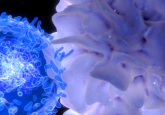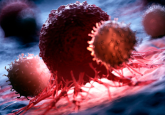Metastasis-associated macrophages identified

Several subsets of macrophage have been found to closely associate with metastasis-initiating cells in the tumor microenvironment.
A team of researchers at the Johns Hopkins Kimmel Cancer Center (MD, USA) have used mass cytometry to identify a subset of immune cells positioned closest to metastasis-initiating cells of breast cancer tumors. By improving our understanding of the arrangement of immune cells in the tumor microenvironment (TME), these findings could offer some novel targets for the improvement of cancer immunotherapies.
Immunotherapies present an exciting new paradigm for the treatment of cancer, but their effectiveness is currently limited to subsets of patients and a select few cancer types. Current efforts in the field of immuno-oncology are focused on the identification of new cellular targets for immunotherapies to broaden the number of cancer types they can target and to increase the proportion of patients with these cancers that successfully respond to the therapies.
Multiple teams at Johns Hopkins have been pursuing this aim and recent developments from the cancer center have identified a series of biomarkers in breast cancer cells that indicate their likelihood of metastasizing. These biomarkers include cytokeratin-14 and E-cadherin in cells of luminal tumors and E-cadherin and vimentin in cells of triple-negative tumors.
Building on this work, the team searched for 36 of the biomarkers identified using mass cytometry to locate metastasis-initiating cells in tumor samples from 24 patients who had died of breast cancer. Using the same principles, the team identified the cells within 10–20 microns of the metastasis-initiating cells.
 A technique for the masses: single-cell analysis using mass cytometry
A technique for the masses: single-cell analysis using mass cytometry
Mass cytometry, a technique that bridges the gap between flow cytometry and mass spectrometry, reveals how immune cell distribution differs in disease states, such as in the peripheral blood of coronary artery disease patients and the lesion microenvironment of endometriosis.
From the resulting dataset of 1,477,337 annotated cells, the team was able to determine some interesting trends in the cells closest to the metastasis-initiating cells. “What popped out at us, among immune system cells, was a subset of macrophages very close to or touching metastasis-initiating cells in the primary and metastatic tissue samples,” revealed co-senior author Won Jin Ho. The presence of the macrophage subtypes, including CD163int, CD206int, PDL1int, HLA-DR+ or PDL1high, and ARG1high, was subsequently confirmed in a different dataset of 100 breast cancer samples.
Previous studies have shown that a high concentration of macrophages in the TME can be indicative of poor prognosis, an observation that corresponds with these findings as it could be an indicator of a large number of cells on the cusp of metastasis.
The authors hypothesize that the close spatial relationship of these high-risk cells and the macrophage subtypes could indicate that the macrophages play a role in metastasis and that they could even provide a new potential target for therapeutics, one day leading to interventions that could, “change how neighborhoods of cancer cells are organized,” according to co-senior author Andrew Ewald.





